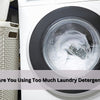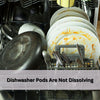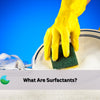The Cleaning Power of Saponins: A Natural Way to Tackle Grease & Grime
- by Brodie Cook

Why Natural Cleaning Matters
More people are switching to plant-based cleaners due to environmental concerns. They want products that are safe to use around family and pets. Harsh chemicals can cause skin irritation and leave behind nasties on floors. Some can trigger allergies or affect air quality inside the home.
Many traditional cleaners use ammonia and bleach. These chemicals can damage surfaces and leave a sticky residue. They also wash into waterways, harming marine life and polluting water supplies.
That’s why we use saponins as one of the ingredients in our floor cleaning sheets. These plant-based surfactants break down grease and lift dirt with ease. No harsh chemicals, no toxins, just a powerful clean that’s safe for your home.
What Are Saponins?
Why Do They Work So Well
Saponins clean by breaking down grease at a molecular level. They work like synthetic cleaners but come from plants instead of chemicals. They act as natural emulsifiers, helping water and oil mix. This makes them powerful against dirt and grime without leaving behind residues.
When mixed with water, saponins create a soapy like foam. This foam lifts dirt so it can be wiped away. Many synthetic cleaners use artificial foaming agents, but saponins do it naturally. They bond with both water and oils, loosening grime instead of spreading it around.
Grease and oil usually repel water, which is why many cleaners need strong degreasers. Saponins break through this barrier so grease can dissolve and rinse away. According to ScienceDirect, saponins lower surface tension, helping water spread evenly and clean more effectively.
Where Do Saponins Come From?

Saponins come from plants that have been used for cleaning and other purposes for a long time. Some plants contain higher levels, making them ideal for cleaning products.
- Soapbark Tree (Quillaja saponaria) – A key source of saponins used in plant-based cleaners. The bark is processed to extract powerful cleaning agents.
- Soapnuts (Sapindus mukorossi) – These small fruits release saponins when soaked in water, making them a natural alternative to detergent.
- Yucca – Used in some cleaning and personal care products for its ability to break down dirt and grease.
- Ginseng – Contains saponins that help lift dirt and oils from surfaces.
- Agave – A plant known for its many uses, including as a source of saponins in some natural cleaners.
Saponins vs. Traditional Cleaners: What’s the Difference?
| Feature | Saponin-Based Cleaners | Traditional Chemical Cleaners |
|---|---|---|
| Origin | Plant-based | Synthetic chemicals |
| Environmental Impact | Biodegradable | Can pollute water systems |
| Residue | No harsh chemicals left behind | Can leave toxic residues |
| Safety | Non-toxic | Often contain irritants |
| Cleaning Power | Effective on grease & grime | Can contain harsher surfactants |
How Saponins Are Used in Floor Cleaning Products
Saponins are one of the key ingredients in your floor cleaning sheets. When mixed with water, they create a powerful cleaning solution that lifts dirt and leaves floors spotless.
These sheets are made for convenience. Each one dissolves fully, creating the perfect amount of cleaner for your spray mop. No need to measure. No heavy bottles to carry. Just drop a sheet in water and start cleaning.
Unlike traditional cleaners, saponins work without leaving sticky residues. They help prevent streaks and stop dirt from building up. That means cleaner floors for longer with less effort. Safe for tiles, laminate, and vinyl, they make floor cleaning easier than ever.
Why Choose our Cleaning Sheets Over Liquid Detergents?
Less Waste, More Cleaning Power
Liquid cleaners come in bulky plastic bottles that take up space and create waste. Our floor cleaning sheets are compact, lightweight, and dissolve completely in water. No spills, no mess, just the right amount of cleaning solution every time.
No Harsh Chemicals or Nasties
Many liquid cleaners rely on synthetic surfactants and artificial fragrances. These can leave behind sticky residues and irritate skin. Our sheets use plant-based ingredients, including saponins, for a deep clean without the nasties.
Perfect for Spray Mop Systems
Liquid cleaners often require measuring and rinsing. Our sheets are pre-measured and designed for spray mops. Drop a sheet into water, let it dissolve, and you’re ready to clean. No extra steps, no wasted product.
Streak-Free Finish
Some liquid cleaners leave behind streaks or film, especially on tiles and laminate. Our formula ensures an even clean without residue, keeping your floors looking fresh for longer.

 Dishwashing
Dishwashing Laundry
Laundry Bundles
Bundles Surfaces
Surfaces Toilet
Toilet Handsoap
Handsoap Multi-Purpose
Multi-Purpose Floor
Floor




